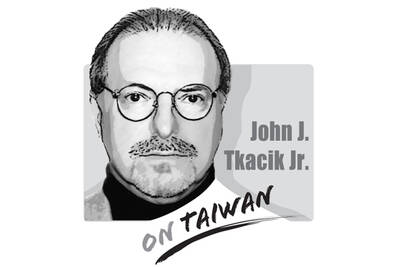The victory of Vice President William Lai (賴清德) in January’s presidential election raised questions about the future of China’s unification strategy toward Taiwan.
A decade ago, the assumption in Bejing had been that deepening economic ties with Taiwan would bring about a political accommodation eventually leading to political integration. Not only has this not happened, but it hastened the opposite. Taiwanese are more concerned with safeguarding their political independence than they have ever been.
China’s preferred party, the Chinese Nationalist Party (KMT), has not won a presidential election since 2012. Clearly, Beijing’s strategy is not working.
Polling conducted by the Institute of European and American Studies at Academia Sinica in its “American Portrait” survey last year showed that just 9.3 percent of respondents believed China was a “credible” country and 82.7 percent believed the threat from China had increased in recent years.
More recent polling conducted by the Mainland Affairs Council showed that more than 60 percent supported maintaining the “status quo” indefinitely.
This is bad news for Beijing’s “peaceful unification” strategy, which relies on Taiwanese willingness to embrace unification. With the peaceful plan stalling, an impatient Beijing has three options:
First, it can ramp up coercion — which it is doing. However, this is a suboptimal tactic, as it hardens Taiwanese resolve. Second is an all-out invasion, which is far too risky, as the Chinese People’s Liberation Army cannot be sure of victory. Third, revise and rejig the peaceful unification strategy.
In the wake of Lai’s election, two components of this rejigging have emerged. The first is to use pro-China politicians in Taiwan to undermine the elected government. This is in line with the emphasis on “uniting patriotic forces,” which came out of the Taiwan Work Affairs Conference in February. This has taken form in former president Ma Ying Jeou’s (馬英九) visit to China earlier this month and KMT caucus whip Fu Kun-chi (?) leading a delegation to Beijing this week to name just two examples.
The second is Beijing’s renewed focus on young Taiwanese. An indication of this priority was evident when Chinese President Xi Jinping (習近平), during his meeting with Ma, said that young Taiwanese were welcome to “pursue, build and realize their dreams” in China.
“I hope young people on both sides of the Taiwan Strait will learn from each other,” he added.
Beijing is ramping up its propaganda efforts and economic offerings to young Taiwanese. For example, last year Beijing launched its Fujian Proposal — an initiative that aims to foster China-Taiwan ties through a “demonstration zone for integrated development” in Fujian Province. The proposal is in part directed at young Taiwanese by offering lower thresholds to get into good universities in the province and providing high-paying job opportunities.
“Despite the developmental gap between the two societies, Beijing believes its preferential policies towards newcomers from Taiwan, particularly the youth, are appealing and productive,” Lin Gang (林岡), a professor at the Center for Fujian-Taiwan Area Studies, wrote recently.
Chinese academics writing in a Xiamen University journal focused on Taiwan affairs recently said that the rising popularity of Chinese apps such as Xiaohongshu, or “Little Red Book,” among Taiwanese is good for China.
“As long as the mainland works properly, it can win the support of Taiwan’s Generation Z and create a rational and pragmatic young generation,” they wrote.
Although certainly not authoritative, these statements suggest that Beijing has faith in its ability to influence Taiwanese society over the long term and has not abandoned “peaceful unification.”

On May 7, 1971, Henry Kissinger planned his first, ultra-secret mission to China and pondered whether it would be better to meet his Chinese interlocutors “in Pakistan where the Pakistanis would tape the meeting — or in China where the Chinese would do the taping.” After a flicker of thought, he decided to have the Chinese do all the tape recording, translating and transcribing. Fortuitously, historians have several thousand pages of verbatim texts of Dr. Kissinger’s negotiations with his Chinese counterparts. Paradoxically, behind the scenes, Chinese stenographers prepared verbatim English language typescripts faster than they could translate and type them
More than 30 years ago when I immigrated to the US, applied for citizenship and took the 100-question civics test, the one part of the naturalization process that left the deepest impression on me was one question on the N-400 form, which asked: “Have you ever been a member of, involved in or in any way associated with any communist or totalitarian party anywhere in the world?” Answering “yes” could lead to the rejection of your application. Some people might try their luck and lie, but if exposed, the consequences could be much worse — a person could be fined,
Taiwan aims to elevate its strategic position in supply chains by becoming an artificial intelligence (AI) hub for Nvidia Corp, providing everything from advanced chips and components to servers, in an attempt to edge out its closest rival in the region, South Korea. Taiwan’s importance in the AI ecosystem was clearly reflected in three major announcements Nvidia made during this year’s Computex trade show in Taipei. First, the US company’s number of partners in Taiwan would surge to 122 this year, from 34 last year, according to a slide shown during CEO Jensen Huang’s (黃仁勳) keynote speech on Monday last week.
On May 13, the Legislative Yuan passed an amendment to Article 6 of the Nuclear Reactor Facilities Regulation Act (核子反應器設施管制法) that would extend the life of nuclear reactors from 40 to 60 years, thereby providing a legal basis for the extension or reactivation of nuclear power plants. On May 20, Chinese Nationalist Party (KMT) and Taiwan People’s Party (TPP) legislators used their numerical advantage to pass the TPP caucus’ proposal for a public referendum that would determine whether the Ma-anshan Nuclear Power Plant should resume operations, provided it is deemed safe by the authorities. The Central Election Commission (CEC) has